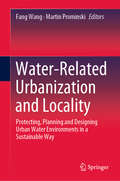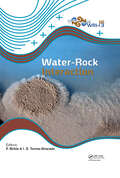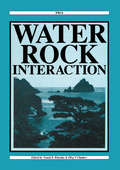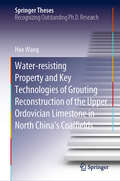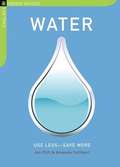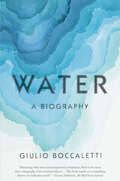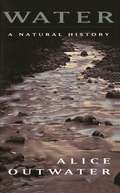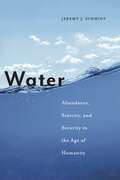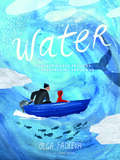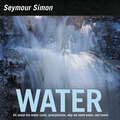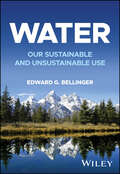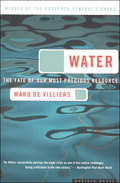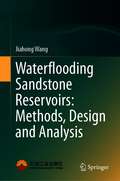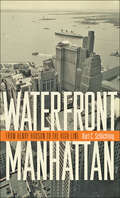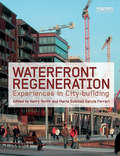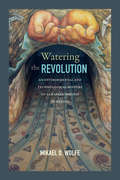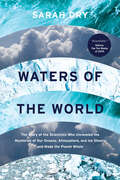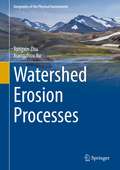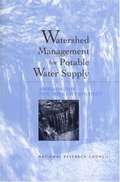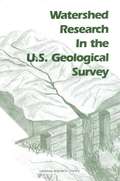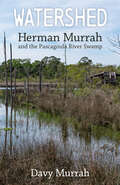- Table View
- List View
Water-Related Urbanization and Locality: Protecting, Planning and Designing Urban Water Environments in a Sustainable Way
by Fang Wang Martin ProminskiThis book discusses the protection, planning, and design of sustainable urban water environments. Against the backdrop of environmental changes, it addresses issues of water resource protection and sustainable development in China and Germany at different stages of urbanization, as well as relevant strategies and lessons learned. It focuses on three topics: balance between water environment protection and utilization in the urbanization process; sustainable use of water resources in the urbanization process; and water-related planning and design strategies in urbanization and local cultural development processes. In the context of water resources, China and Germany can learn from each other’s experiences and can support one another in the fields of urbanization and locality. As such, the book brings together Chinese and Germans scientists from various disciplines, such as planning, geography, landscape, architecture, tourism, ecology, hydraulic engineering and history to provide a multicultural and multidisciplinary perspective on the topic and examine the challenges and opportunities as well as the planning and design strategies to achieve sustainable, water-related urban spaces. By combining theoretical and practical approaches, it appeals to academics and practitioners around the globe.
Water-Rock Interaction XIII
by Peter Birkle Ignacio S. Torres-AlvaradoIn the late 18th century, Neptunists and Plutonists had controversial opinions about the formation of the Earth and its lithological units. The former believed that rocks formed from the crystallization of minerals in the early Earth's oceans, the latter believed that rocks were formed in fire. Both theories ignored the importance of continuous wat
Water-Rock Interaction: Proceedings of the 8th international symposium, WRI-8, Vladivostok, Russia, 15-19 August 1995
by YOUSIF K. KHARAKA; OLEG V. CHUDAEVWater-rock interactions play an important role in nearly all physical and chemical processes operating on the Earth's surface and subsurface. This work contains the proceedings of the Eighth International Symposium on Water-Rock Interaction (WRI-8), held in Russia in 1995.
Water-resisting Property and Key Technologies of Grouting Reconstruction of the Upper Ordovician Limestone in North China’s Coalfields (Springer Theses)
by Hao WangThis book examines the water resistance capacity of the Upper Ordovician limestone and its feasibility as a water barrier to achieve safe and green mining. Mine water inrush events often occur during coal mine construction and production; they account for a large proportion of the coal mine disasters and accidents in China, second only to gas explosions. As mining depths and mining intensity continue to increase, the hydrogeological conditions encountered are becoming more complex. This book describes in-situ methods designed to test the water resistance of the limestone layer, as well as specific grouting techniques developed to transform this layer into a barrier that can prevent water inrush during mining. The innovative technologies, which were applied and validated in two coal mines, are applicable to other coal mines or any underground engineering works.
Water: 100 Energy-Saving Tips for the Home
by Jon Clift Amanda Cuthbert100 simple and effective tips for saving water, inside and outdoors of your home or business. Packed with practical ideas for your kitchen, bath, landscaping, and water using chores.
Water: A Biography
by Giulio BoccalettiSpanning millennia and continents, here is a stunningly revealing history of how the distribution of water has shaped human civilization. Boccaletti, of The Nature Conservancy, &“tackles the most important story of our time: our relationship with water in a world of looming scarcity&” (Kelly McEvers, NPR Host). Writing with authority and brio, Giulio Boccaletti—honorary research associate at the Smith School of Enterprise and the Environment, University of Oxford—shrewdly combines environmental and social history, beginning with the earliest civilizations of sedentary farmers on the banks of the Nile, the Tigris, and the Euphrates Rivers. Even as he describes how these societies were made possible by sea-level changes from the last glacial melt, he incisively examines how this type of farming led to irrigation and multiple cropping, which, in turn, led to a population explosion and labor specialization. We see with clarity how irrigation&’s structure informed social structure (inventions such as the calendar sprung from agricultural necessity); how in ancient Greece, the communal ownership of wells laid the groundwork for democracy; how the Greek and Roman experiences with water security resulted in systems of taxation; and how the modern world as we know it began with a legal framework for the development of water infrastructure. Extraordinary for its monumental scope and piercing insightfulness, Water: A Biography richly enlarges our understanding of our relationship to—and fundamental reliance on—the most elemental substance on earth.
Water: A Natural History
by Alice OutwaterAn environmental engineer turned ecology writer relates the history of our waterways and her own growing understanding of why our waterways continue to be polluted#151;and what needs to be done to save this essential natural resourse. Water: A Natural History takes us back to the diaries of the first Western explorers; it moves from the reservoir to the modern toliet, from the grasslands of the Midwest to the Everglades of Florida, throught the guts of a wastewater treatment plant and out to the waterways again. It shows how human-engineered dams, canals and farms replaces nature’s beaver dams, prairie dog tunnels, and buffalo wallows. Step by step, Outwater makes clear what should have always been obvious: while engineering can depollute water, only ecologically interacting systems can create healthy waterways. Important reading for students of environmental studies, the heart of this history is a vision of our land and waterways as they once were, and a plan that can restore them to their former glory: a land of living streams, public lands with hundreds of millions of beaver-built wetlands, prairie dog towns that increase the amount of rainfall that percolates to the groundwater, and forests that feed their fallen trees to the sea.
Water: Abundance, Scarcity, and Security in the Age of Humanity (Global Challenges In Water Governance Ser.)
by Jeremy J. SchmidtAn intellectual history of America's water management philosophyHumans take more than their geological share of water, but they do not benefit from it equally. This imbalance has created an era of intense water scarcity that affects the security of individuals, states, and the global economy. For many, this brazen water grab and the social inequalities it produces reflect the lack of a coherent philosophy connecting people to the planet. Challenging this view, Jeremy Schmidt shows how water was made a “resource” that linked geology, politics, and culture to American institutions. Understanding the global spread and evolution of this philosophy is now key to addressing inequalities that exist on a geological scale. Water: Abundance, Scarcity, and Security in the Age of Humanity details the remarkable intellectual history of America’s water management philosophy. It shows how this philosophy shaped early twentieth-century conservation in the United States, influenced American international development programs, and ultimately shaped programs of global governance that today connect water resources to the Earth system. Schmidt demonstrates how the ways we think about water reflect specific public and societal values, and illuminates the process by which the American approach to water management came to dominate the global conversation about water. Debates over how human impacts on the planet are connected to a new geological epoch—the Anthropocene—tend to focus on either the social causes of environmental crises or scientific assessments of the Earth system. Schmidt shows how, when it comes to water, the two are one and the same. The very way we think about managing water resources validates putting ever more water to use for some human purposes at the expense of others.
Water: Discovering the Precious Resource All Around Us (Spectacular STEAM for Curious Readers (SSCR))
by Olga FadeevaA curiosity-sparking book about water in rainstorms, the Great Lakes, the drip from our taps, and other places in our world. Water is everywhere, and we rely on it every single day. But do you ever wonder about water? How much water is on our planet? What happens when there is too much water or too little water? Why does it rain? What are lakes, rivers, seas, and oceans? Why are the seas and oceans blue and salty? What lives underwater? What about water in human history—how did people get water in ancient times? How do we get water today? What do humans build to travel on the water, and how have we harnessed waterpower? How do we protect this amazing resource for the future? Gorgeous and informative, Water invites children to tour through science and history with two characters they may recognize from Wind: Discovering Air in Motion. Colorful acrylic art and energetic text help readers learn about the natural resource we have depended on since the beginning of life itself.
Water: FOSS Science Stories
by University of California at Berkeley Lawrence Hall of ScienceNIMAC-sourced textbook
Water: Hands-on Early-learning Science Activities: In The Water (Seymour Simon Science Ser.)
by Seymour SimonThis nonfiction photo essay picture book from award-winning science writer Seymour Simon explores the one thing on Earth we cannot live without: water!Learn all about the water cycle, the effect on our planet of rising ocean temperatures, how essential clean water is around the world, and more!This nonfiction picture book is packed with information and beautiful color photographs. Kids ages 6 to 10 looking for facts, whether for a report or just for fun, will find much to like in Water.Also includes:• author’s note• stunning full-color photographs• glossary• index• additional reading sourcesSupports the Common Core Learning Standards, Next Generation Science Standards and the Science, Technology, Engineering, and Math (STEM) standards.
Water: Our Sustainable and Unsustainable Use
by Edward G. BellingerA holistic approach to humanity’s global use and management of water resources In Water: Our Sustainable and Unsustainable Use, distinguished environmental researcher Edward Bellinger delivers an unbiased and scientifically accurate exploration of every major area of the management and use of water by human beings. Readers will benefit from a coordinated and holistic approach to the subject, including sections covering needs, availability, governance, public health engineering, economics, the potential effects of climate change, water management, and sustainability, allowing the reader to understand the big picture of global water use under conditions of declining water resources. Assuming only basic knowledge in hydrology, Water: Our Sustainable and Unsustainable Use is international in scope and includes case studies from across the globe. The book also offers: A thorough introduction to human and ecological water needs and how they interact A discussion of available water resources and systemic problems of water quality A comprehensive analysis of the human water footprint and factors driving water demand in modern society An overview of the technological aspects of drinking water supply and sanitation, as well as the governance and management of waterPerfect for undergraduate and graduate students studying hydrology and related subjects, Water: Our Sustainable and Unsustainable Use will also earn a place in the libraries of administrators, regulators, and economists involved in water resources management, as well as conservationists and ecologists.
Water: The Fate of Our Most Precious Resource
by Marq De VilliersIn his award-winning book WATER, Marq de Villiers provides an eye-opening account of how we are using, misusing, and abusing our planet's most vital resource. Encompassing ecological, historical, and cultural perspectives, de Villiers reports from hot spots as diverse as China, Las Vegas, and the Middle East, where swelling populations and unchecked development have stressed fresh water supplies nearly beyond remedy. Political struggles for control of water rage around the globe, and rampant pollution daily poses dire ecological theats. With one eye on these looming crises and the other on the history of our dependence on our planet's most precious commodity, de Villiers has crafted a powerful narrative about the lifeblood of civilizations that will be "a wake-up call for concerned citizens, environmentalists, policymakers, and water drinkers everywhere" (Publishers Weekly).
Water: The Fate of Our Most Precious Resource
by Mauq De VilliersOverview of past, present, and potential future problems endangering the world's water supply. Index and Notes not included.
Waterflooding Sandstone Reservoirs: Methods, Design and Analysis
by Jiahong WangThis book focuses on oilfield performance analysis and development adjustment by integrating geology, applied mathematics, and other relevant theories. Based on the abundant and detailed field test and production data from Daqing and Tarim, two major oilfields in China, the regularities, characteristics, design, and adjustment of waterflooding development of sandstone reservoirs throughout the life cycle are described. Field development theories and practices are organically combined in this book, which, embracing comprehensive, systematic, and pragmatic contents, is conducive to development technicians to quickly grasp the characteristics of waterflooding and prepare adjustment plans. It is also useful as a textbook in petroleum colleges and short training courses.
Waterfront Manhattan: From Henry Hudson to the High Line
by Kurt C. SchlichtingThe waterfront was the key to New York City’s growth and prosperity.For hundreds of years, the shorefront of Manhattan Island served as the country’s center of trade, shipping, and commerce. With its maritime links across the oceans, along the Atlantic coast, and inland to the Midwest and New England, Manhattan became a global city and home to the world’s busiest port. It was a world of docks, ships, tugboats, and ferries, filled with cargo and freight, a place where millions of immigrants entered the Promised Land. In Waterfront Manhattan, Kurt C. Schlichting tells the story of the Manhattan waterfront as a struggle between public and private control of New York’s priceless asset. Nature provided New York with a sheltered harbor but presented the city with a challenge: to find the necessary capital to build and expand the maritime infrastructure. From colonial times until after the Civil War, the city ceded control of the waterfront to private interests, excluding the public entirely and sparking a battle between shipping companies, the railroads, and ferries for access to the waterfront. In the second half of the nineteenth century, the City of New York regained control of the waterfront, but a whirlwind of forces beyond the control of either public or private interests—technological change in the form of the shipping container and the jet airplane—devastated the city’s maritime world. The city slowly and painfully recovered. Visionaries reimagined the waterfront, and today the island is almost completely surrounded by parkland, the world of piers and longshoremen gone, replaced by luxury housing and tourist attractions.Waterfront Manhattan is a wide-ranging history that will dazzle anyone who is fascinated by New York.
Waterfront Regeneration: Experiences in City-building
by Harry Smith Maria Soledad Garcia FerrariWaterfront regeneration and development represents a unique opportunity to spatially and visually alter cities worldwide. However, its multi-faceted nature entails city-building with all its complexity including the full range of organizations involved and how they interact. This book examines how more inclusive stakeholder involvement has been attempted in the nine cities that took part in the European Union funded Waterfront Communities Project. It focuses on analyzing the experience of creating new public realms through city-building activities. These public realms include negotiation arenas in which different discourses meet and are created – including those of planners, urban designers and architects, politicians, developers, landowners and community groups – as well as physical environments where the new city districts' public life can take place, drawing lessons for waterfront regeneration worldwide. The book opens with an introduction to waterfront regeneration and then provides a framework for analyzing and comparing waterfront redevelopments, which is followed by individual case study chapters highlighting specific topics and issues including land ownership and control, decision making in planning processes, the role of planners in public space planning, visions for waterfront living, citizen participation, design-based waterfront developments, a social approach to urban waterfront regeneration and successful place making. Significant findings include the difficulty of integrating long term 'sustainability' into plans and the realization that climate change adaptation needs to be explicitly integrated into regeneration planning. The transferable insights and ideas in this book are ideal for practising and student urban planners and designers working on developing plans for long-term sustainable waterfront regeneration anywhere in the world.
Watering the Revolution: An Environmental and Technological History of Agrarian Reform in Mexico
by Mikael D. WolfeIn Watering the Revolution Mikael D. Wolfe transforms our understanding of Mexican agrarian reform through an environmental and technological history of water management in the emblematic Laguna region. Drawing on extensive archival research in Mexico and the United States, Wolfe shows how during the long Mexican Revolution (1910-1940) engineers’ distribution of water paradoxically undermined land distribution. In so doing, he highlights the intrinsic tension engineers faced between the urgent need for water conservation and the imperative for development during the contentious modernization of the Laguna's existing flood irrigation method into one regulated by high dams, concrete-lined canals, and motorized groundwater pumps. This tension generally resolved in favor of development, which unintentionally diminished and contaminated the water supply while deepening existing rural social inequalities by dividing people into water haves and have-nots, regardless of their access to land. By uncovering the varied motivations behind the Mexican government’s decision to use invasive and damaging technologies despite knowing they were ecologically unsustainable, Wolfe tells a cautionary tale of the long-term consequences of short-sighted development policies.
Waters of the World: The Story of the Scientists Who Unraveled the Mysteries of Our Oceans, Atmosphere, and Ice Sheets and Made the Planet Whole
by Sarah DryA Nature Top Ten Book of the Year: “Immensely readable” accounts of seven pioneers who were at the forefront of what we now call climate science (New York Review of Books).One of Booklist’s Top Ten Sci-Tech Books of the YearFrom the glaciers of the Alps to the towering cumulonimbus clouds of the Caribbean and the unexpectedly chaotic flows of the North Atlantic, Waters of the World is a tour through 150 years of the history of a significant but underappreciated idea: that the Earth has a global climate system made up of interconnected parts, constantly changing on all scales of both time and space. A prerequisite for the discovery of global warming and climate change, this idea was forged by scientists studying water in its myriad forms. This is their story.Linking the history of the planet with the lives of those who studied it, Sarah Dry follows the remarkable scientists who summited volcanic peaks to peer through an atmosphere’s worth of water vapor, cored mile-thick ice sheets to uncover the Earth’s ancient climate history, and flew inside storm clouds to understand how small changes in energy can produce both massive storms and the general circulation of the Earth’s atmosphere. Each toiled on his or her own corner of the planetary puzzle. Gradually, their cumulative discoveries coalesced into a unified working theory of our planet’s climate.We now call this field climate science, and in recent years it has provoked great passions, anxieties, and warnings. But no less than the object of its study, the science of water and climate is—and always has been—evolving. By revealing the complexity of this history, Waters of the World delivers a better understanding of our planet’s climate at a time when we need it the most.“One of the richest books I have ever read . . . a beautifully written, episodic, yet comprehensive, history of the diverse scientific underpinnings of climate science over the past two hundred years.” —Environmental History“Smart, compelling, and timely . . . By focusing on specific scientists, Dry gifts readers with entertaining portraits of some thoroughly interesting if largely unknown individuals.”—Booklist (starred review)
Watershed Erosion Processes (Geography of the Physical Environment)
by Xiangzhou Xu Tongxin ZhuThis monograph is a fundamental study of watershed erosion and runoff processes. It utilizes decades of soil erosion data to take a comprehensive and balanced approach in covering various watershed erosion processes. While there are many works on soil erosion and conservation, this book fills the gaps in previously published research by focusing more on mass movement, gully erosion, soil piping/tunnel erosion, and the spatial interactions of different erosion processes. Additionally, the book examines erosion processes in extreme rainfall events, something typically absent in short-term studies but discussed in detail here as the book draws on 60 years of research and observations, including 30 years of the author's own investigations of erosion under a wide range of rainfall conditions. The book is divided into 3 parts, and is intended for soil erosion researchers and practitioners, and postgraduate students studying soil erosion and water conservation. Part 1 opens with a comprehensive and critical review of existing literature on soil erosion processes, discusses this book's place among existing literature, and examines the major erosion processes (rainwash, gully erosion, tunnel erosion, and mass movements) including their controlling factors and mechanisms. Part 2 explores the spatial interactions of these different erosion processes to provide a prerequisite for effective design of comprehensive soil erosion control measures in a watershed. Part 3 evaluates the relative significance of these erosion processes in sediment production, the effectiveness of comprehensive soil and water conservation programs, and the applications of watershed modelling in determining the impact of land-use changes on soil erosion and other ecological processes.
Watershed Management for Potable Water Supply: Assessing the New York City Strategy
by National Research CouncilIn 1997, New York City adopted a mammoth watershed agreement to protect its drinking water and avoid filtration of its large upstate surface water supply. Shortly thereafter, the NRC began an analysis of the agreement's scientific validity.The resulting book finds New York City's watershed agreement to be a good template for proactive watershed management that, if properly implemented, will maintain high water quality. However, it cautions that the agreement is not a guarantee of permanent filtration avoidance because of changing regulations, uncertainties regarding pollution sources, advances in treatment technologies, and natural variations in watershed conditions.The book recommends that New York City place its highest priority on pathogenic microorganisms in the watershed and direct its resources toward improving methods for detecting pathogens, understanding pathogen transport and fate, and demonstrating that best management practices will remove pathogens. Other recommendations, which are broadly applicable to surface water supplies across the country, target buffer zones, stormwater management, water quality monitoring, and effluent trading.
Watershed Research in the U.S. Geological Survey
by Committee on U.S. Geological Survey Water Resources ResearchInformation on Watershed Research in the U.S. Geological Survey
Watershed: Attending to Body and Earth in Distress
by Ranae Lenor HansonA personal health crisis, stories from environmental refugees, and our climate in danger prompt a meditation on intimate connections between the health of the body and the health of the ecosystem The body of the earth, beset by a climate in crisis, experiences drought much like the human body experiences thirst, as Ranae Lenor Hanson&’s body did as a warning sign of the disease that would change her life: Type 1 diabetes. What if we tended to an ailing ecosystem just as Hanson learned to care for herself in the throes of a chronic medical condition. This is the possibility explored in a work that is at once a memoir of illness and health, a contemplation of the surrounding natural world in distress, and a reflection on the ways these come together in personal, local, and global opportunities for healing.Beginning with memories from a childhood nurtured among the waters of Minnesota, Watershed follows the streams and tributaries that connect us to our world and to each other, as revealed in the life stories of Hanson&’s students, Minnesotans driven from their faraway homelands by climate disruption. The book&’s currents carry us to threatened mangrove swamps in Saudi Arabia, to drought-stricken Ethiopia, to rocks bearing ancient messages above crooked rivers in northern Minnesota, to a diabetic crisis in an ICU bed at a St. Paul hospital. With the benefit of gentle insight and a broad worldview, Hanson encourages us at every turn to find our own way, to discover how the health of our bodies and the health of the world they inhabit are inextricably linked and how attending, and tending, to their shared distress can lead to a genuine, grounded wellbeing. When, in the grip of a global pandemic, humans drastically change their behavior to preserve human life, we also see how the earth breathes more freely as a result. In light of that lesson, Watershed helps us to consider our place and our part in the health and healing of the world around us.
Watershed: Herman Murrah and the Pascagoula River Swamp
by Davy MurrahThe Pascagoula River is the largest unobstructed river in the contiguous United States. Because of this lack of restraint, the river has been left to rise and fall naturally with the seasons, overflowing annually into the adjoining bottomland forest. This phenomenon makes the Pascagoula River one of the wildest rivers, surrounded by some of the most ecologically diverse woodlands, in North America.Herman Murrah (1935–2002) lived his entire life on the banks and in the swamp surrounding this river in southeast Mississippi. Watershed: Herman Murrah and the Pascagoula River Swamp recounts pivotal moments in Herman’s life and in Mississippi’s conservation history more broadly. In this book, Herman’s eldest son, Davy, details the adventures that continue to inspire young conservationists in the fight to protect our remaining natural ecosystems.As a young adult, Herman worked as a game warden in the Pascagoula River Swamp. When the Pascagoula Hardwood Company, then owners of the swamp, decided to sell the vast tract of forest for clearcutting, Herman was incensed. Determined to protect this natural wonder, Herman teamed up with other visionaries to persuade the State of Mississippi to purchase the land and preserve it in perpetuity to the benefit of future generations of humans and wildlife alike. Eventually, the state agreed and finalized the purchase. Herman was appointed area manager for the upper portion of the newly designated Pascagoula River Wildlife Management Area. He dedicated the remainder of his life to preserving, protecting, and improving the swamp for the good of south Mississippi.
